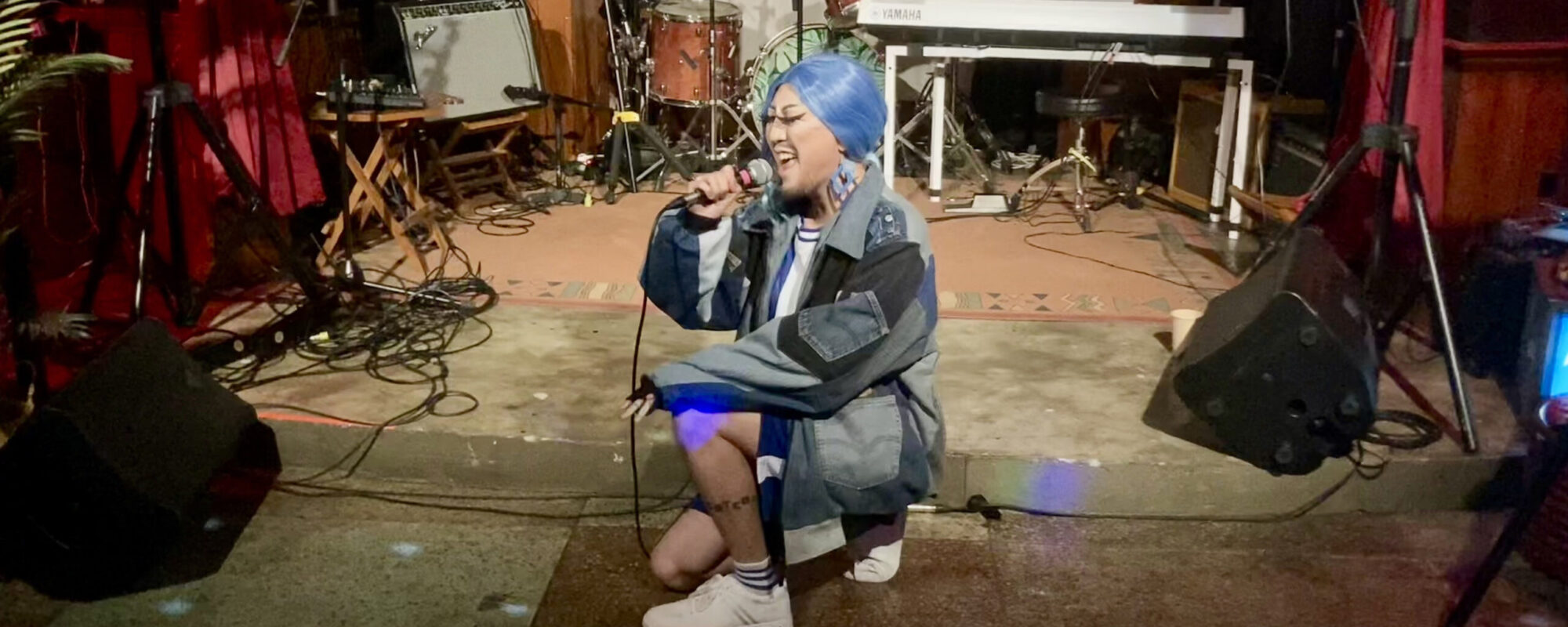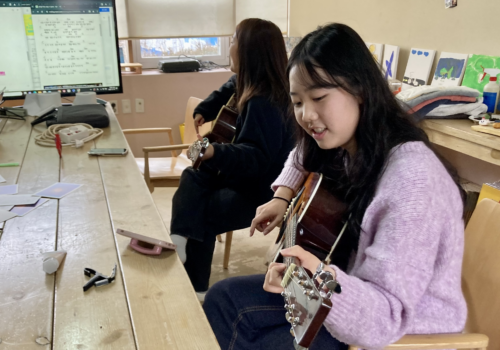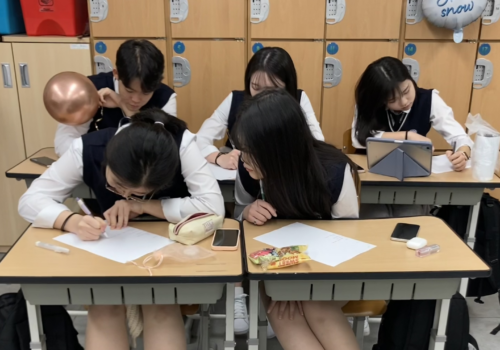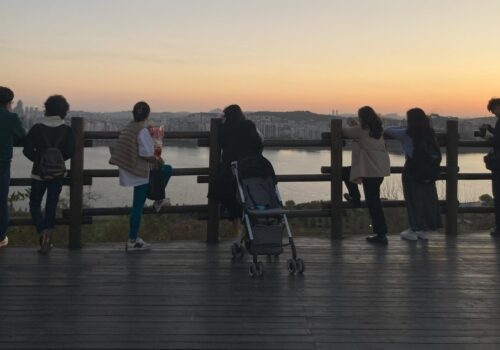SEOUL — Today, the neighborhood of Hongdae, a vibrant commercial and cultural district teeming with college students, is one of the queerest parts of the capital, housing several lesbian clubs and LGBTQ-owned restaurants and bars. But when the drag performer Hurricane Kimchi was growing up there in the 1990s and 2000s, the LGBTQ community was practically invisible.
“There were no resources, no way to connect with other queer people,” Hurricane Kimchi told me in Itaewon, Seoul’s most famous gay neighborhood. “Even gay people didn’t know so much about drag back then. Maybe there were other words for it, like ‘cross-dressing,’ or ‘just dressing up for fun.’ Not drag as we know it now.”
Off stage, Hurricane Kimchi—also known as queer artist and activist Heezy Yang—is instantly recognizable by their collection of small face tattoos, trim beard and always-present beanie. Despite their gentle manner, they have a surprising tendency to deliver harsh truths about things like homophobia and racism in a matter-of-fact tone.
I had been familiar with Yang’s drag performances and organizing work before coming to South Korea, but now I was in Seoul, the artist seemed ubiquitous. I ran into them at LGBTQ events. Interviewees advised me to seek their insights. Queer influencers shared their selfies, comics and calls to action. One time, I was admiring wall art at an LGBTQ club only to realize that it, too, was created by Yang.
Yang is an important figure in Korean drag and the LGBTQ community more broadly. Since the early 2010s, they have worked to promote LGBTQ equality in South Korea and create queer-friendly spaces for performances, art and community. Their story highlights how much has changed for queer Koreans in recent decades, but also how much change has yet to come.
Since the 1990s, South Korea has gone through seismic political shifts—economic booms and busts, a democratic transition and more—and its LGBTQ culture has shifted, too, seeing an explosion of new civil society groups. Public awareness of LGBTQ identities has increased, as has support for equal rights, especially among young people.
For drag in particular, the past decade has seen a surge of interest in line with global trends. Today, Seoul’s gay-friendly neighborhoods are home to several bars that host weekly drag nights, brunches and more. Drag performers have appeared in music videos for high-profile K-pop groups such as Mamamoo and Girls Generation, while queens like Nana Youngrong Kim have modeled at Seoul Fashion Week. Neon Milk and other influencers have racked up hundreds of thousands of subscribers, increasing the accessibility of drag culture for Korean speakers.
Yang, for their part, has worked to share previously niche information about the Korean LGBTQ culture through art, comics and more, in both Korean and English. They also played an important role bringing drag performers to the capital’s annual Pride event, the Seoul Queer Culture Festival, and in 2018, founded Seoul Drag Parade, an LGBTQ rights organization that hosts regular events and raises money for LGBTQ charities.
“Queer people also deserve to just have fun and relax and be entertained,” Yang told me after a Sunday afternoon Seoul Drag Parade event at KYLDN Social Club, a bar hidden down an alley near Itaewon. “What I’m trying to do is create safe spaces where LGBTQ artists can express themselves and be themselves and share their art. If someone is struggling, if I can navigate them with my art and what I do, then I would be happy with that.”
In a way, Yang is working to create the kind of community they lacked as a child. In middle school, they were bullied for “feminine” traits and ended up adopting hypermasculine behaviors, hoping to blend into their conservative environment. By the time they hit their late teens, they said, they were fed up with hiding.
“As a teenager, I kind of despised Korean society and its norms. We have a very narrow standard of what is normal and what is beautiful, and I was so sick of it,” Yang told me. “So when I became a legal adult, I cut all my ties with what I had before, my friendships and communities and schools and everything. I just started from a clean slate and made completely new friends.”
Nearly all those friends were non-Koreans, who Yang said were generally more “open-minded” when it came to LGBTQ equality. It wasn’t until their mid-to-late 20s that Yang began to “reconnect with my Korean side.”
“I met some good friends who are activists and artists and realized that, oh, these people are just like me,” Yang said. “They hate what I hate, but they still make pure art and try to make the community and the society better. We are like-minded people, and there must be other like-minded people in Korean society.”
Traditionally, drag queens channel an exaggerated Western diva aesthetic, wearing dramatic makeup, large blonde wigs, high heels and tight-fitting dresses, and perform by lip-syncing and dancing along to famous, largely Western pop songs. Many performers at Seoul’s older venues—such as the decades-old Trance in Itaewon—stick to that model.
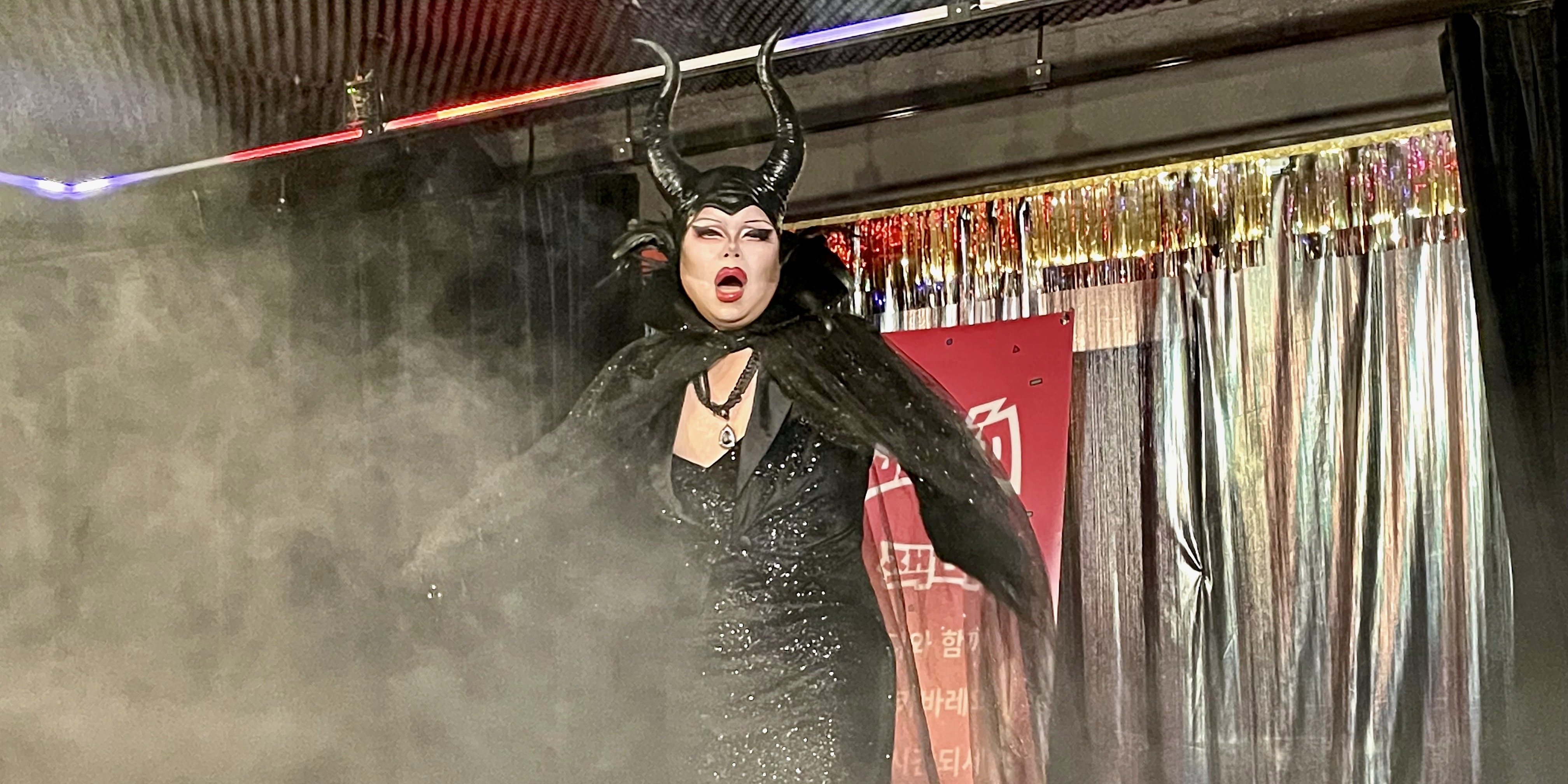
It is interesting that many Korean-run venues are also less up-front about drag’s ties to the LGBTQ community, foregoing rainbows and Pride flags for minimalistic black interiors and performing for largely cisgender, straight spectators who don’t identify as gender or sexual minorities.
Hurricane Kimchi’s drag takes a radically different approach. On stage, they usually wear tight dresses and high heels, but they keep their beard visible and sometimes perform bald, foregoing a wig. They are also adventurous in adding new elements to their set, including by performing live covers and original songs and, last month, by pulling their boyfriend on stage to serenade him.
Indeed, Seoul Drag Parade’s monthly cabarets are intentionally diverse, LGBTQ-friendly events. In March, every performer had something unusual to offer, whether by singing or rapping live, choosing songs in various languages, experimenting with aesthetics or adding playful elements of acrobatics and audience participation. Some took their artistry to new levels by hand-making their own outfits, while others rebuffed tradition just by being themselves, representing diverse races, genders, sexualities and body types.
The show-stealer was a Korean veteran queen, Anessa, who emerged from a fog machine’s haze in a glittering black gown and Maleficent-style horns to perform, quite unexpectedly, “Queen of the Night,” from Mozart’s opera “The Magic Flute.” The look and performance were a labor of love, taking a full year to plan and create.
After her performance, during an interview on the roof of KYLDN, Anessa told me her performances make her feel confident and allow forms of expression that go far beyond gender performance.
“Rather than necessarily distinguishing between the masculine and feminine, I think drag hides my original form and expresses another me,” she said in Korean, as the N. Seoul Tower glowed green on the mountain top behind her. “In that way, in drag, men can be women and women can be men. Or a man or woman can take a monster’s shape. It doesn’t matter. It just brings out another form of my inner self.”
Another Korean drag performer, Tropical Marilyn—who goes by the pronoun “it”—stood out at that Sunday’s cabaret because it had traded the conventional dress and heels for a baseball cap, tracksuit and chains to perform the R&B girl group TLC’s “No Scrubs.”
“In drag, you can be anything you want to be, right? So then why do we always dress like what you usually see at a drag show, or on RuPaul?” it told me, explaining that its performance was partly a response to drag’s usual take on femininity. “I want to break that norm. A hip-hop outfit can be just as cool. And I feel more appropriate in this outfit when I’m doing a hip-hop number.”
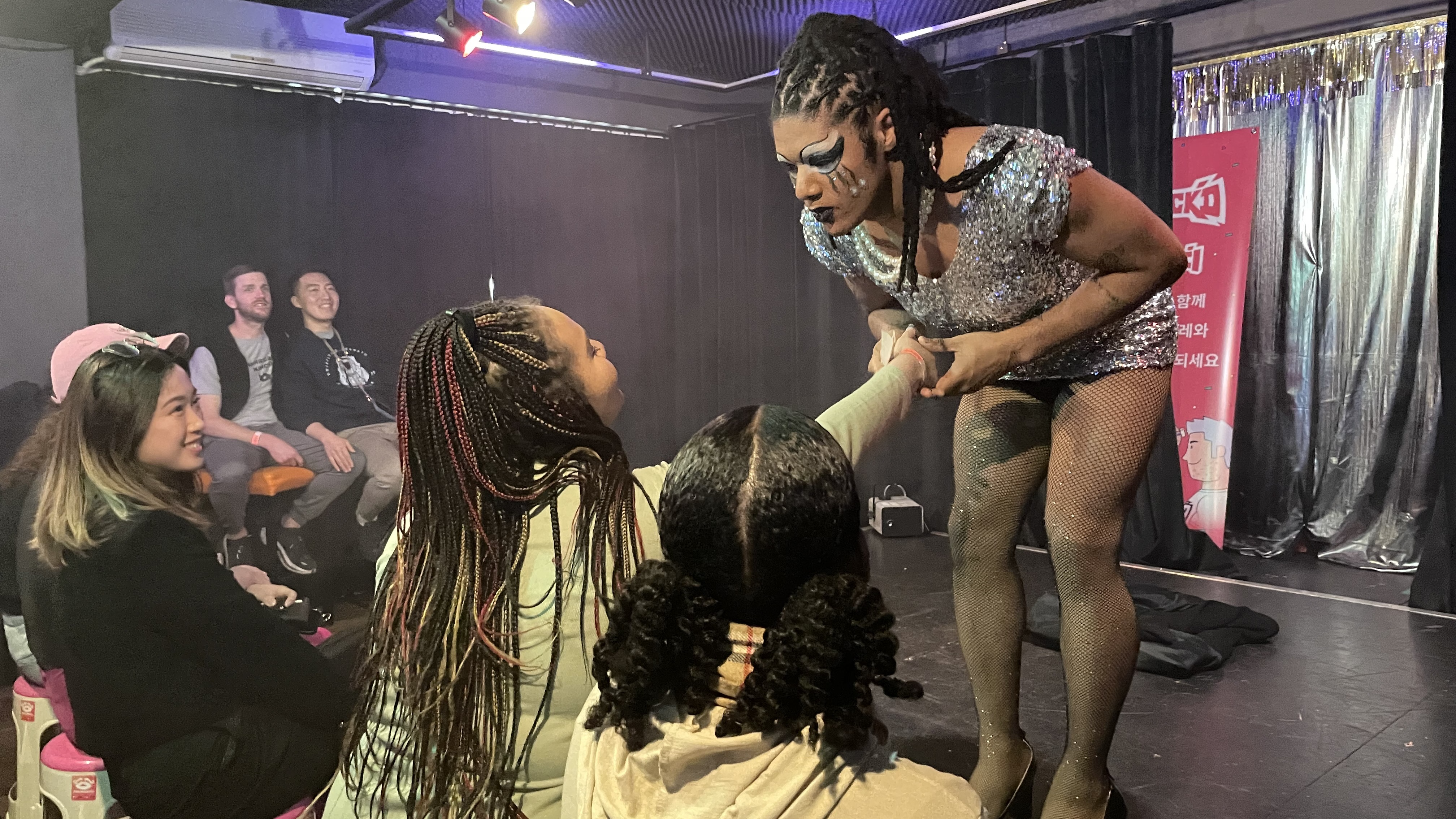
By hosting bilingual events, Yang also hopes to connect the Korean queer community with the queer community of “foreigners,” a term used for everyone not of Korean ethnicity, regardless of how long they have lived in the country. Although exceptions are frequent, for the most part, Korean-run venues book mostly Korean artists and foreigner-run venues mostly book foreigners. Performers and MCs at the former tend to exclusively speak Korean, while those at the latter mostly use English.
“I am one of very few people in the LGBTQ community in Korea who can be the bridge between the two,” Yang told me, explaining that most members of the Korean LGBTQ scene are not multilingual. “Koreans tend to stick together with Koreans, and that creates an invisible wall that foreigners and immigrants can’t easily go over.”
The new vigor in today’s scene may be breaking down some of the barriers in a country that is increasingly international and diverse. One drag performer, Seraphim, who moved to South Korea six years ago and performs as a drag queen, wrestler, actor and model, described the kindness shown by some Korean queens with whom she’s worked, remembering how Anessa—who does not speak English—helped her apply makeup before a show.
Meanwhile, Seraphim noted that her presence as an openly trans performer in the Korean drag and wrestling scene has been meaningful for her Korean fans.
“I’ve had people in my DMs [private messages sent on social media] telling me how they felt more comfortable transitioning because of me,” Seraphim said. “I’m not a famous person. I’ve got a thousand followers on Insta, a thousand followers on YouTube. But just me being myself, me being open, has given visibility to the idea of, ‘Hey, if you don’t like your gender, you can change it.’ ‘If you don’t like your presentation, you can change it.’”
South Korea still has a long way to go in terms of LGBTQ equality. Although polling suggests the general public has become more accepting of queer identities, politicians have failed to pass even the most basic anti-discrimination protections. Annual Pride festivals continue to attract raucous, even violent crowds of counter-protesters, and openly voicing support for the LGBTQ community is still seen as reputationally risky. As a result, Yang said, even when drag makes it to mainstream media, it’s often presented as a politically neutral art form.
“They’re exploiting the entertainment and the fun factor but erasing the LGBTQ,” they said. “I don’t like that, but you gotta start somewhere, and it’s Korea.” Yang noted that the entertainment professionals creating diverse products are still afraid to openly support the equality movement. “When I was growing up, people in Korea didn’t even know that there were LGBTQ people and why there is this thing called racism or misogyny. Now at least there is a conversation about these things.”
“Korea changes really quickly,” they added, noting that it’s been only a little more than 10 years since they were a teenager growing up in Hongdae. “Hopefully we will achieve and change even more in the next decade.”
Top photo: Hurricane Kimchi performs at “We Have Us,” a Trans Day of Remembrance event at Morene Sukha, a live music venue in western Seoul

